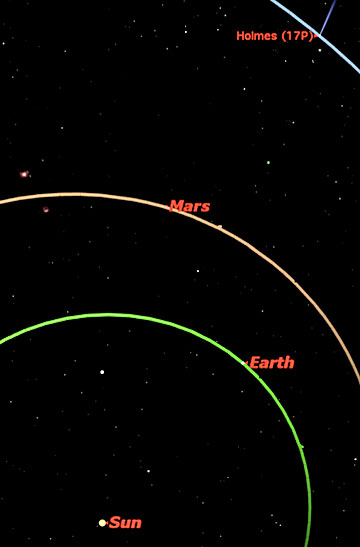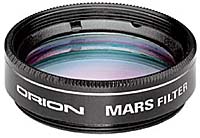|
If you have trouble viewing this newsletter, click here.
Welcome again to our monthly newsletter with features on exciting celestial events, product reviews, tips & tricks, and a monthly sky calendar. We hope you enjoy it!

Available here…
New Features*:
- New Appulse Event Searching alerts you when the Moon is near bright planet;
- New Apollo Space Missions feature lets you explore the trajectories of the Apollo spacecraft not available anywhere else!
- 6 New Earth Horizon Panoramas let you observe from several interesting new locations;
- 65 New 3-D Asteroid Models let you explore these intriguing celestial bodies;
- New Meteor Showers Update makes your meteor shower observations even better;
- New Extrasolar Planets Update helps you learn even more about planets beyond our Solar System;
- New Equipment Database Update means you can use the software with a growing list of equipment;
- Extended Constellation Descriptions provide more detailed information on all 88 constellations;
- Smooth Window Fading (Win XP, Vista) and Transparent Floating Windows (Vista) will enhance your experience;
- And more ….
*Some features might not be available in your version 6 product.
[Top of Page]

If you’ve been following the astronomy groups on the internet lately, you will certainly have heard of the strange case of Comet Holmes (17P). This periodic comet was discovered in 1892 by Edwin Holmes. After discovery it slowly faded from view in the largest telescopes until one night it suddenly popped up to fourth magnitude, close to the Andromeda Galaxy:
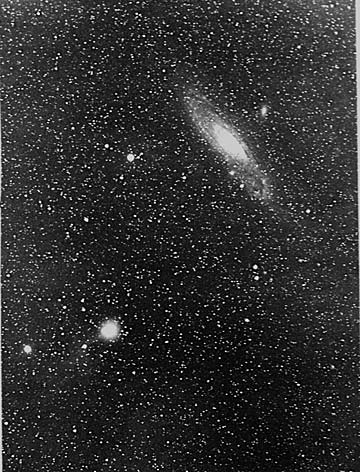
Comet Holmes photographed on 1892 November 10 by E. E. Barnard. The Andromeda Galaxy is at upper right, Mu Andromedae at lower left, with the comet just to the right of it.
On October 23, 2007 Comet Holmes repeated this performance, suddenly going from magnitude 16 to magnitude 2.7, an increase in brightness of close to a million times! This time, it chose another picturesque background for its performance: the brilliant and rich Alpha Persei Cluster. In both cases, the comet had a decidedly un-comet-like appearance: no noticeable tail, looking just like a giant planetary nebula. It followed its spectacular brightening by an equally spectacular enlargement in size, which fooled many observers into thinking it was streaking straight towards us, its tail hidden behind it like the freight train behind a looming locomotive.
We can use Starry Night® to determine what was really going on. Starry Night® has a large number of preset “Favorites” which can help us visualize events taking place in space. With a little bit of tinkering, we can take the Inner Solar System favorite and add the orbits of Jupiter and Comet Holmes to it; for the sake of clarity I’ve deleted Venus and Mercury. The situation with Holmes immediately starts to become evident.
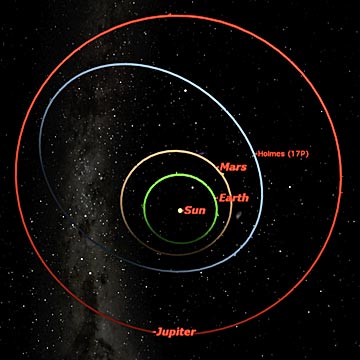
Orbital positions on 2007 October 23, when the Holmes outburst occurred. All the planets and the comet are moving counterclockwise around the Sun from this view from above the Sun’s north pole.
First of all, notice that, like all comets, Holmes has a noticeably elliptical orbit. Secondly, this orbit lies far from the Sun, between the orbits of Mars and Jupiter, in what we usually think of as “the Asteroid Belt.” Thirdly, Holmes is nowhere near perihelion, the point in its orbit closest to the Sun. In fact, it passed perihelion in early May, and was retreating rapidly from the Sun by October. So this outburst was not caused by the Sun’s heat. Because the Earth is closer to the Sun than the comet, it is moving faster around the Sun. The result of this is that, even though the comet was retreating from the Sun, it was actually getting very slowly closer to the Earth, but the change in distance in two weeks between Earth and Holmes was less than one percent. Thus the rapid enlargement observed with Holmes was due to its actually increasing in physical size, not a perspective effect caused by decreasing distance between the two.
Zooming in on this diagram helps us to understand what’s going on with Holmes’ tail:
Notice that Holmes’ tail is pointing away from the Sun, in the direction of the solar wind, as is normal. Seen from the perspective of Earth, the tail is streaming out behind the head of the comet, and so is hidden from us; hence Holmes’ round tail-less appearance.
Many Starry Night® users were surprised that Starry Night® wasn’t showing Comet Holmes at its proper brightness. This is because our source of comet orbital elements, the file Comets.txt which is downloaded automatically by Starry Night®, did not automatically update the absolute magnitude of the comet after its outburst. This is something which you can update yourself by clicking on the menu button to the left of Comet Holmes’ listing in the Find panel. Choose “Edit Orbital Elements…” and click on the “Other Settings” tab. Change the absolute magnitude from 10.0 to –4.3. Close the window, saving the change. Changing the comet’s magnitude in this way overrides the magnitude in the Comets.txt file, so that the comet’s brightness will continue to display accurately even after updating the Comets.txt file.
The charts above are just snapshots of the positions of the Sun, Earth, and Comet Holmes on the day of its eruption. To see them interact in four dimensions, download this file <Holmes.snf.zip>, unzip it, open it in Starry Night®, and then move forward and backward in time.
Geoff Gaherty
Geoff has been a life-long telescope addict, and is active in many areas of visual observation; he is a moderator of the Yahoo "Talking Telescopes" group.
[Top of Page]

One of the nicest things about Starry Night® is that it can serve as a bridge to people who aren't quite as interested in astronomy as I am. This holiday season I decided that I wanted to show my "normal" friends and family what Starry Night® could tell them about Christmas.
The Christmas Star, or "Star of Bethlehem", reportedly acted as a beacon for the Three Wise Men to follow from the Middle East to Bethlehem and Jesus' birth.
I've heard many explanations over the years: a comet, a supernova, meteors, a supernatural event. Now, I have access to the perfect simulation tool.
Here's what I did...
From what I could learn, most astronomers and Biblical scholars believe that the appearance of the Star of Bethlehem most likely occurred sometime between the years 7 and 2 BC. Was there anything unusual in the sky that might have caught the attention of the wise men?
Just so happened that a very close conjunction of Venus and Jupiter would have been visible in the eastern dawn sky of the Middle East from about 3:45 to 5:20 a.m. on August 12, 3 BC. The two planets came together in the constellation of Leo. To the early Israelites, Leo was a constellation of great astrological significance and considered a sacred part of the sky. The planets came so close together that most people saw it as one object – a very striking sight.
With this information, I used Starry Night® to go back in time and recreate the August 12, 3 B.C. event.
You can do it too...
- Change your Viewing Location to Bethlehem, West Bank.
- Set the date in Starry Night to August 12, 3 B.C. (not A.D.)
- Set the time to 4:30 a.m.
- Turn on the constellation stick figures (press K on your keyboard if using version 4 or 5)
- Face East (press E on your keyboard)
- You should see a bright star just above the horizon and slightly to the left in the constellation of Leo.
- Turn on the planet labels. You should now see that the bright star is not a star at all but in fact two planets - Venus and Jupiter.
- Right-click (Ctrl-click on the Mac) on the bright star and select Centre from the popup menu that comes up.
- Zoom in using the zoom buttons. Note how close the two planets were!
- If you want to save this view as an .SNF file – select Save from the File menu.
Note...
Finally, for more info on the Star of Bethlehem, check out “Star of Bethlehem: Going back in time to explore its origins” from the fine folks at Space.com.
Seth Meyers
VP of Consumer Products and Experiences
Imaginova®
[Top of Page]

Ho ho ho! It’s getting to be that time of year again, when I get to play Santa and browse through the Orion® catalog looking for goodies to put in some astronomer’s stocking. Remember, the rules of the game are to print out these pages, mark the things you’d like with a big red marker, and leave in some prominent location as a not-so-subtle hint to your loved ones. Everything on this list is either something I own myself, or wish I did!
$10 and under
$2.95 #07406
Winged Rubber Eyeguard
Is your neighbor’s porch light driving you crazy? Then you need this little rubber eyeguard to slip over your eyepiece so that you can shut out the outside world.
$3.95 #05833
Microfiber OptiCloth
Did Junior get fingerprints all over your Nagler? Time to get out the OptiCloth to soak up the oil and leave the lens sparkling clean!
$3.95 #05940
Observer's Eyepatch
Avast, me hearties! Is it Talk Like a Pirate Day? No, it’s look like a pirate: put this patch over your non-observing eye and enjoy the relaxed pleasure of observing with both eyes wide open.
$9.95 #05831
LensPen Mini Pro
But what about those short focal length eyepieces with tiny eye lenses? This miniature LensPen will let you get into the tiniest lenses and clean them up.
$9.95 #05613
DC Adapter Cable with Auto Lighter Plug
Does your GoTo scope eat up batteries? Use this cable to connect to your car’s battery or a standalone battery power pack. It even includes the weird little plug that only Celestron seems to use in the entire world.
$10 to $20
$10.95 #51466
Sky & Telescope Field Map of the Moon
This is the nicest Moon map I’ve seen. It’s laminated and unfolds to a large diameter showing close to a thousand named features on the Moon, drawn by Antonín Rükl.
$14.95 up #04203
FlexiShield Dew Caps
If you have a Maksutov- or Schmidt-Cassegrain, you probably also have dew. These flexible dew shields will keep your corrector plate dew-free for hours, as well as shielding you from stray light. They’re light weight and store in no space at all.
$16.95 #51501
Star Watch
My favorite guidebook for locating the Messier objects and much more.
$17.95 #04150
DeepMap 600 Folding Star Chart
This is just about the handiest star map there is. It folds up and fits into your pocket like a road map, but is printed on durable plastic. It’s also a checklist of the finest 600 deep sky objects in the sky.
$19.95 #17208
Starry Night® Constellation Adventure
This is Starry Night® for kids! It’s a simplified version of my favorite planetarium program, with a lot of neat extras that kids will love.
$20 to $30
$21.95 #05272
2" Visual Back for Schmidt Cassegrain Telescopes
Tired of the narrow view of your Schmidt-Cassegrain? This is a real eye-opener, allowing you to use 2” diameter eyepieces and accessories.
$24.95 #59137
Celestial Sampler: 60 Small-Scope Tours
This is a collection of Sue French’s popular sky tours from Sky & Telescope. She strikes a nice balance between familiar showpieces and lesser known wonders.
$26.95 #05756
DualBeam LED Astro Flashlight
This is the handiest observing flashlight I’ve ever seen. It switches between two red LEDs to preserve your night vision, and two white LEDs for observing the Moon and finding the screw you dropped in the grass. It comes with a lanyard to hang it around your neck so you’ll never lose it.
$26.95 up #05973
Deluxe Accessory Cases
These cases protect your precious eyepieces, filters, and other accessories while also allowing you to organize everything so it’s easy to find things in the dark.
$30 to $40
$32.95 #20034
Beginning Stargazer's Toolkit
This kit has everything you need to get you started with a new telescope: a planisphere, a Moon map, a book on the constellations, and even a red LED flashlight!
$34.95 #07033
Precision Slow-Motion Adapter
This is an essential accessory for anyone who owns a Coronado Personal Solar Telescope. It allows you to mount the PST atop a camera tripod but still be able to track the Sun with great precision. It’s also a great aid for any small scope mounted on a camera tripod.
$34.95 #15178
Orion Waist Case Accessory Holder
Well, I got my Deluxe Accessory Case (see above) and filled it so full of stuff I could hardly lift it. I recently added one of these nifty Waist Cases, which weighs nothing and keeps essential eyepieces and filters right at hand (or hip).
$40 to $50
$42.95 #03640
Collimating Eyepiece
Many new owners of Newtonians buy laser collimators thinking they will solve all their collimation problems. Wrong! Every telescope first needs to be collimated with a sight tube and Cheshire eyepiece before a laser can be used. This beautifully machined device contains both essential collimation tools in one piece.
$42.95 and up #08739
Sirius Plössl Eyepieces
Everybody can use another eyepiece, right? Most scopes come with a 25 mm and a 10 mm, but you will soon want the wider fields of view provided by a 32 mm or the lunar and planetary close-ups of a 7.5 mm or 6.3 mm. Or maybe something in between…
$44.95 #05599
Orion Mars Observation Filter, 1.25"
This is new this year, and perfectly timed for the current apparition of Mars. I usually don’t recommend filters for planetary observation, but this one is the exception. Thanks to its interference technology (similar to a nebula filter) it combines the effects of a red filter (to enhance the contrast of surface features) and a blue filter (to enhance the polar cap and Martian clouds) while blocking most of the glare from the middle wavelengths. The result is that all the detail you want to see is enhanced, while the contrast-killing glare is banished!
$44.95 #51500
Backyard Astronomer's Guide, Second Edition
Back in the ‘50s and ‘60s, J. B. Sidgwick’s books were the amateur astronomer’s bible. Well, now it’s the 21st century and the “new testament” is Terence Dickinson and Alan Dyer’s wonderfully illustrated guide to everything an amateur astronomer needs to know. This is probably the most used book on my bookshelf.
$49.95 #17237
Starry Night® Complete Space & Astronomy Pack
This is the basic user-friendly version of Starry Night®, my favorite planetarium software. Besides its beautiful depiction of the night sky, it gives you a huge number of guided tours to teach you about the universe, and even includes a bonus DVD with all sorts of nifty astronomical presentations. Perfect for somebody just getting started in astronomy.
So those are my choices for the 2007 holiday season. I hope you receive the ones you want, and have lots of astronomical joy in 2008!
Geoff Gaherty
Geoff has been a life-long telescope addict, and is active in many areas of visual observation; he is a moderator of the Yahoo "Talking Telescopes" group.
[Top of Page]

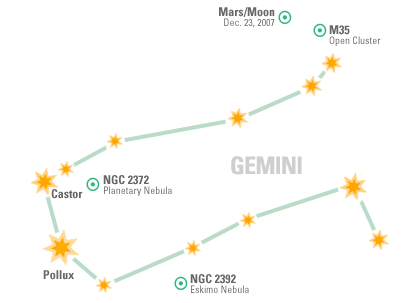
Gemini is well placed for observations in December, floating high overhead in the south-east by late evening.
Castor is an easy, pretty double which resolves nicely in small scopes. A true double, the stars revolve around each other every 510 years.
Close by is NGC 2372, a faint planetary nebula that looks like a mini-dumbbell.
The Eskimo Nebula (NGC 2392), photographed so magnificently by the Hubble Space Telescope, is also known the Clown Face Nebula. Only large scopes bring out the details you would associate with a face, but it's a fun target nonetheless.
M35 (NGC 2168) is a lovely open cluster by Gemini's left foot, with a smaller, dimmer but rich companion cluster NGC 2158; physically unrelated, they just happen to lie along the same line of sight.
Sean O'Dwyer
Starry Night® Times Editor
[Top of Page]

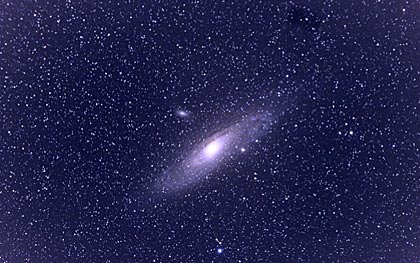
Ken Stewart took this image of the Andromeda Galaxy (M31) with his new CG-5 mount on Aug. 11, 2007 with a Canon 20D, 70-200mm f/4L lens @ 200mm. 50 frames X 30 sec. exposures.
PRIZES AND RULES:
We would like to invite all Starry Night® users to send their quality astronomy photographs to be considered for use in our monthly newsletter.
- Featured submissions (best of month) will receive a prize of $75 USD.
Please read the following guidelines and see the submission e-mail address below.
- Format: Digital images in either JPG, GIF or TIFF format.
- Size: 700 pixels wide maximum.
- File size should be less than 2 MB.
- Include a caption: Your full name, location where photo was taken and any interesting details regarding your photo or how you took it. Please be brief.
- Important notes: We may edit captions for clarity and brevity. We reserve the right to not use submissions. In submitting your image or images to Imaginova®, you agree to allow us to publish them in all media—on the Web or otherwise—now and in the future. We'll credit you, of course. Most important, you'll have the satisfaction of sharing your experience with the world!
- Send images, following the above guidelines, to photo@starrynight.com (by sending an image you agree to the above terms, including Imaginova®’s right to publish your photos). Please do not send .ZIP files as they will not reach us.
[Top of Page]
|
 |
 |
 |
 |
 |
 |
 |
Mars Observing Guide
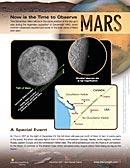
Now is the time to observe Mars. This December, Mars will be in the same position in the sky as it was during the legendary apparition of December 1960, when northern observers experienced some of the best views of Mars ever seen. Our observing guide will help you get the most out of this event.
|
 |
 |
Pedro Braganca
Content Director,
Starry Night®
|
 |
 |
 |
 |
 |
 |
 |

A guided video tour of celestial events visible this month.
• Click Here to Download
|
 |
 |
 |
 |
 |
 |
 |
Are you a teacher or educator?
Visit the Starry Night® Education Discussion Group. It has just started and we hope it will become a place to share ideas, lessons and files related to using Starry Night® in the classroom. If you share a passion for learning, please join us.
Pedro Braganca
Content Director,
Starry Night®
|
 |
 |
 |
 |
 |
 |
 |
Moon Phases
 Full Moon: Full Moon:
Dec 23
8:15 PM
 Last Quarter: Last Quarter:
Dec 1
7:44 AM
 New Moon: New Moon:
Dec 9
12:40 PM
 First Quarter: First Quarter:
Dec 17
5:17 AM
Observing Highlights
Sun., Dec. 23
Mars at its brightest, 11:16 AM
Although Mars was nearest to Earth on the 18th, today is the date when the combination of nearness and phase make it brightest (magnitude -1.6) of the year. However, the change from night to night is not great enough to note. Look for the Moon to pass very near by later in the evening.
Sun., Dec. 23
Moon-Mars, 10:00 PM
The Moon passes less than a degree from very bright Mars. In fact, observers in northern Canada, Alaska, the Arctic and parts of Europe may see an occultation (basically, an eclipse) of Mars by the Moon. For a map and more information on the occultation, see the International Occultation Timing Association page.
Planets
Mercury is in line with the Sun on the 17th and so is lost in the glare until January, when it will emerge into the evening twilight.
Venus, strictly speaking, has passed it maximum in brilliancy, but you could hardly notice! It is still a mighty beacon in the predawn eastern sky, spawning gasps of amazement from most and even mistaken reports of UFOs. Look eastward an hour before sunrise and if you don't see Venus, it is cloudy!
Mars: this is an important month for Mars-watchers. In Gemini, it is the nearest it has been to Earth in two years on the 18th, then reaches opposition on Christmas Eve and is occulted by the Moon (as seen from the far North) on the same day.
Jupiter spends most of the month in Sagittarius, but too close to the Sun to be seen easily. It is in conjunction on the 23rd, and won't be seen again until late January. Then it is in the morning sky.
Saturn, in Leo, is about 90 degrees from the Sun, which means that it rises late at night and is at its highest at about sunrise. The Moon passes nearby on Dec. 1.
Dates
Sat., Dec. 1
Moon/Saturn, 8:10 AM
The Moon passes by Saturn, in Leo, in the predawn eastern sky. Closest approach of just less than 2.5 degrees is after sunrise in the East, but easily visible in the West. Saturn appears as the fairly bright "star" above the Moon. The other bright star nearby is Regulus.
Wed., Dec. 5
Moon/Venus, predawn
The Moon passes about 7 degrees from Venus in the predawn southeast sky. Almost directly above the Waning Crescent Moon is the star Spica, and the three objects make a nice triangle before dawn. Closest approach is actually late in the afternoon, but none of these will be above the horizon at the time.1
Fri., Dec. 14
Geminid Meteor Shower Peak, 12:00 PM
The peak of this shower comes in daylight throughout most of North America (except northern Canada, Alaska and Hawaii), but Gemini can be seen in the western sky before dawn, and in the east by mid evening. The best conditions likely will be from midnight until down on Friday.
Mon., Dec. 17
Mercury in superior conjunction, 10:34 AM
Superior conjunction occurs when a planet is in line with the Earth and the Sun, but on the far side of the Sun. It cannot be observed, but it marks the point at which Mercury technically moves from the morning sky back into the evening sky, where it will reappear in January.
Tue., Dec. 18
Mars at Perigee, 6:47 PM
Perigee is the point at which an object is closest to Earth. This is near the time when a planet appears brightest, and for superior planets (those farther from the Sun than Earth), it is very near the time when the planet appears opposite the Sun. In this case, the date of maximum brightness is the 23rd, and opposition is on Christmas Eve. On this date, Mars is about 54.8 million miles, or 88.2 million km, from Earth.
Thurs., Dec. 20
Saturn begins retrograde motion, 7:15 AM
When the Earth "passes" a slower moving outer planet, that planet (Saturn in this case) appears to move backward for a while, just as a slower moving car appears to move backward when you pass it. This cannot be seen on a single night, but is apparent if you pay close attention to the planet's position relative to the stars over a few weeks. Since planets normally appear to progress slowly eastward among the stars, during retrograde motion they appear to move westward.
Sat., Dec. 22
Solstice, 1:08 AM
The Northern Hemisphere of Earth is tilted as far away from the Sun as it gets, and the Sun is lowest at midday. Winter begins in the Northern Hemisphere, Summer in the Southern. Note that the Earth is also nearly at its closest approach to the Sun (See Jan. 2). So for us in the North, we are closer to the Sun in Winter than in Summer. It is not the slight change in distance that causes the seasons, but rather the tilt toward or away from the Sun.
Sun., Dec. 23
Jupiter in Conjunction, 12:49 AM
A planet in conjunction typically cannot be seen because it is too closely in line with the Sun. Technically this is a "superior" conjunction (see Dec. 17 above), but since Jupiter is always farther from the Sun than the Earth, we can drop the "superior" and just call it a "conjunction." Although this cannot be seen, it marks the date when Jupiter moves from technically being in the evening sky to being in the morning sky.
Mon., Dec. 24
Mars in opposition, 2:43 PM
Opposition means that the planet is opposite the Sun, similar in situation to the case of the Full Moon. Since it is opposite the Sun, this means that in general it rises about sunset and sets at about sunrise. Being opposite the Sun, the planet also is "full" and due to the geometry of the Earth and Mars's orbit, it closest to the Earth at that time. Of course this also means that it is at its brightest at or near the time of opposition (see Dec. 23).
Wed., Jan. 2
Earth at Perihelion, 7:11 PM
The Earth's distance to the Sun varies a bit during the year, and oddly enough, we are closest (perihelion) in early January. Today the Sun is just 91.4 million miles (about 147.1 million km) away! On July 4, it is about 94.5 million miles away.)
[Data for this calendar has been derived from a number of sources including the Observer’s Handbook 2007 of the Royal Astronomical Society of Canada, Starry Night® software, and others. Only events with a reasonable possibility for Northern Hemisphere observers, or those events with some other significance, are given.]
As always, there's more to explore on NightSky.
All times shown are U.S. Eastern Time.
|
 |
 |
 |
 |
 |
 |
 |
Join the Starry Night® Affiliate Program
If you publish a space or astronomy Web site or blog, earn extra cash by promoting Starry Night® on your Web site.
Click here to learn more!
It's easy to join and it's free!
|
 |
 |
 |
 |
 |
 |
 |
Send us your feedback
Do you have a question, comment, suggestion or article idea to pass along to Starry Night® Times?
Click here to get in touch with us.
|
 |
 |
 |
 |
 |
 |
 |
Starry Night® is the world's leading line of astronomy software and DVDs. Visit starrynight.com to see all the great products we offer for everyone from novice to experienced astronomers.
You have received this e-mail as a trial user of Starry Night® Digital Download or as a registrant at starrynight.com.
Starry Night® is a division of Imaginova® Corp.
To unsubscribe, click here.
To subscribe, sign up here.
Imaginova® Corp.
470 Park Ave South
9th Floor
New York, NY 10016
|
 |
 |
|




